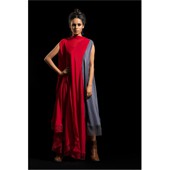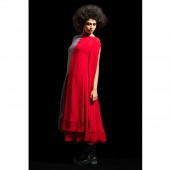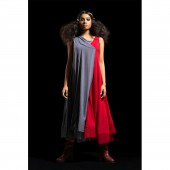
| THE AWARD |
| CATEGORIES |
| REGISTRATION |
| SUBMIT YOUR WORK |
| ENTRY INSTRUCTIONS |
| TERMS & CONDITIONS |
| PUBLICATIONS |
| DATES & FEES |
| METHODOLOGY |
| CONTACT |
| WINNERS |
| PRESS ROOM |
| GET INVOLVED |
| DESIGN PRIZE |
| DESIGN STORE |
| THE AWARD | JURY | CATEGORIES | REGISTRATION | PRESS | WINNERS | PUBLICATIONS | ENTRY INSTRUCTIONS |
Urban Army Garment by Megha Garg |
Home > Winners > Design #64580 >Interview |
 |
|
FS: What is the main principle, idea and inspiration behind your design?
MG: The inspiration behind the collection comes from a basic Indian upper garment kurta and a rectangular piece of scarf like fabric draped above the shoulder which is a dupatta. Both the kurta and the dupatta are a popular pieces of clothing owing their origins to the Vedic times. The idea was to make a garment for the global urban women keeping the elements from the kurta and the dupatta in mind. Hence, came the ideation for the methods used to create the Urban Army series of dresses, referred to by us as kurta dresses. Different cut panels of dupatta in crepe were used to cover the upper part of the body, keeping the shoulders fitted and the rest of the panels hanging loosely. The shoulder ares was then stitched and any open sides of the flowing panels were overlapped and sewn together to complete the garment. The idea behind using different cuts of dupatta inspired panels was to give variety to the same method of making an outfit. Adding colours, differnt lengths and a hemline with net border brought about style differentiation. Hence, the kurta dresses were developed giving it a modern twist and global appeal.
FS: What has been your main focus in designing this work? Especially what did you want to achieve?
MG: The main focus was to deliver, to our customers, something which has its roots in India yet had a global appeal. Nothing is closer to staple upper garment kurta and the versatile appeal due to its wearability. We wanted to make something which is light, wearable yet unique in its approach and look.
FS: What are your future plans for this award winning design?
MG: I want to promote the design to reach out to maximum customers who can enjoy wearing the garment. I also intend to make it a part of a collection in a museum.
FS: How long did it take you to design this particular concept?
MG: The project started in in August 2016 in Kolkata and finished in October 2017 in Kolkata/India, and was exhibited in The India Story, Kolkata in October 2016
FS: Why did you design this particular concept? Was this design commissioned or did you decide to pursuit an inspiration?
MG: It was designed specifically to suit the Indian body type and achieve greater depth in draped upper garment. It was purely out of my personal curiosity that this project was realized. It was the growing demand for light weight occasion wear dresses which not only serves a purpose but also has deep meaning attached to it.
FS: Is your design being produced or used by another company, or do you plan to sell or lease the production rights or do you intent to produce your work yourself?
MG: All the work is produced by my own company and no rights have been transferred for production or selling of the work.
FS: What made you design this particular type of work?
MG: I wanted to experiment with panels of fabric, as to how can they be used to create a garment which is versatile.
FS: Where there any other designs and/or designers that helped the influence the design of your work?
MG: There were no influence from any other designs or designers.
FS: Who is the target customer for his design?
MG: Women from the age group of 25-55 years. They are mostly cosmopolitan women who are aware of their choices.
FS: What sets this design apart from other similar or resembling concepts?
MG: From colour blocking to single tones each of these dresses are unique in their drapes where no two dresses can be draped in the same way and do not look the same. Hence, each piece is unique in its own style. The usp of the collection is that each piece is draped separately. Available in an interesting mix of colours in crape and flat chiffon, this collection is a wardrobe essential
FS: How did you come up with the name for this design? What does it mean?
MG: There is a growing awareness in the youth today for their society. They want a change and want it real fast. They are working towards it in their own ways , in their sphere of work. These are the silent soldiers who will fight the battle against the injustice and the non-progressive views prevalent under the so-called sophisticated societies. We call them the ‘Urban Army’. Keeping them as inspiration a collection of fuss free flowy draped dresses inspired from kurta and dupatta is developed.
FS: Which design tools did you use when you were working on this project?
MG: Each garment of this collection is uniquely draped from trapeze cut panels of 60 gms crepe and 50 gms flat silk chiffons. Every panel is finished with a woven stiff net border at the hem to give a bounce effect to each drape. Sewn on a single needle flat stitch machine the basic technique of overlap and stitch is used to complete each outfit.
FS: What is the most unique aspect of your design?
MG: The most unique aspect is that no two drapes dresses are same. Each style is a different drape giving each garment of the collection an exclusive look.
FS: Who did you collaborate with for this design? Did you work with people with technical / specialized skills?
MG: I have a team of technicians and assistants who help in realizing the garment.
FS: What is the role of technology in this particular design?
MG: The garment was stitched in an single needle lock stitch machine. Thats the only technology used.
FS: Is your design influenced by data or analytical research in any way? What kind of research did you conduct for making this design?
MG: Went through a visual research of the type of Indian garment most preferred by the Indian subcontinent. The result was a kurta, a loose upper garment worn by both men and women. Our being a women only brand , we looked for ways to get the feel and purpose of the kurta with a contemporary twist to be worn as an occasion wear. Focussing on keeping the upper body fitted, rounds of experiments began to look for an theory behind making the new version. We added another element of another popular garment, the dupatta. A dupatta is a rectangualr piece of cloth worn over the shoulder or around the neck teamed with a kurta and a lower garment. Hence came a theory for the Urban Army series of dresses.Taking 5-6 dupattas which were made to hang from differnt parts of the shoulder a kurta dress was created. The shoulder area and open sides were stitched to make a complete garment. With the basic direction of the method , various elements were then added. The sided of each panel of dupatta was stitched, Differnet shapes of dupatta was used, the hem of each dupatta panel eas highlighed with a net border(another Indian element), played with various colours and draping styles, to reach to the end design. By perfecting the technique and process the series of these kurta dresses(as we call it) have a global appeal. They come with a fitted bodysuit inner which takes care of any open sides of the dupatta panels. The collection is already launched in the stores and is a fast seller considering its suitability on all body types. The research has led to the development of a versatile garment which is still connected to its roots.
FS: What are some of the challenges you faced during the design/realization of your concept?
MG: The most challenging part of the research was how to make the garment appealing without any embellishment and yet offer new variety with each style. We wanted to come to a methodlogy which would apply to all yet give different results so that the end customer is satisfied with the uniqueness of the product. Hence we adopted the draping different cuts and pattern of the dupatta panels. This was we made sure that each design will look different from other, yet be similar in the lines of fabric and technique.
FS: How did you decide to submit your design to an international design competition?
MG: We received an invite from the A'Design Award to submit our 'Urban Army' designs for nominations. After the second invitation we decided to submit our design.
FS: What did you learn or how did you improve yourself during the designing of this work?
MG: Any journey we take always makes us better at what we do. With the designing of this work I learnt how to make mistakes and letting all guards down. Sometimes we have to unlearn and re-learn to produce good work. Going back to the roots and keeping it simple was the new lesson which has broaden my perspective for ideating and designing.
FS: Any other things you would like to cover that have not been covered in these questions?
MG: Would like to share the poem behind the inspiration of this collection. THE URBAN ARMY Shy in her demeanor, She held her breath tight, For she was about to take, A leap of confidence and might. Looking out with a different view, She was confident in her sight, Blurring everything else, She took a long flight. Long did she fly, She inspired other wings, Caught in shackles of illusions, They finally set themselves free. She flew with all her might, Leaving all her limits aside, She flew like a bird with open wings, Living the dream of her life. _MEGHA GARG
FS: Thank you for providing us with this opportunity to interview you.
A' Design Award and Competitions grants rights to press members and bloggers to use parts of this interview. This interview is provided as it is; DesignPRWire and A' Design Award and Competitions cannot be held responsible for the answers given by participating designers.
| SOCIAL |
| + Add to Likes / Favorites | Send to My Email | Comment | View Press-Release | Translations |




